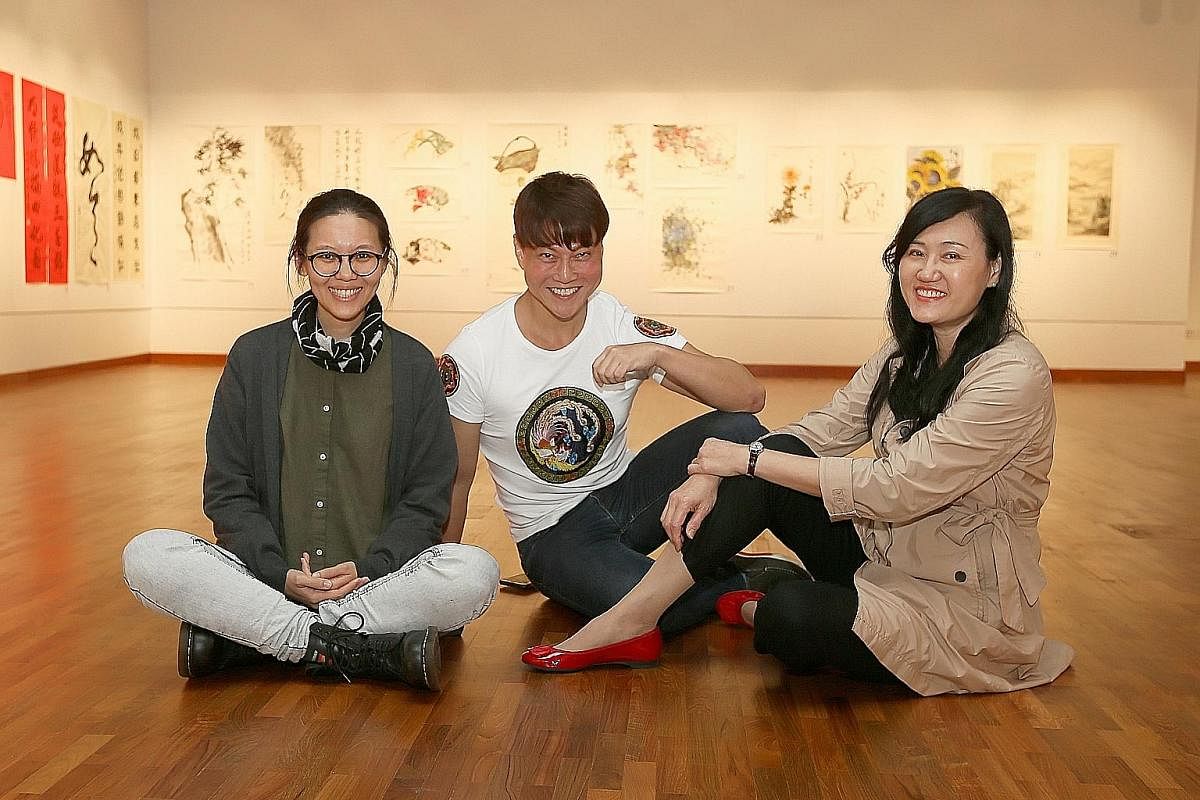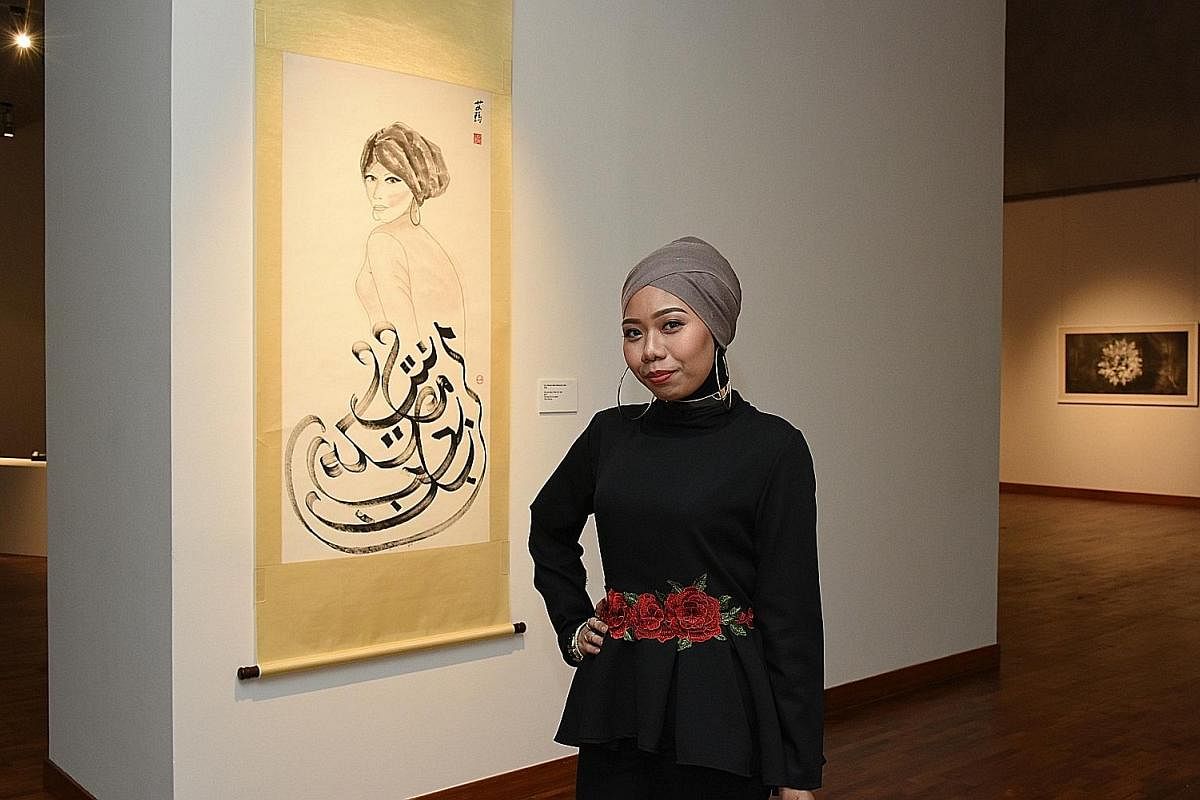-
VIEW IT / PERCEPTIONS - CHINESE INK AT NAFA
-
WHERE: Lim Hak Tai Gallery, Nanyang Academy of Fine Arts (Nafa) Campus 1, 80 Bencoolen Street
WHEN: Until Feb 25, 11am to 7pm (Tuesdays to Sundays), closed on Mondays and public holidays
ADMISSION: Free
INFO: bit.ly/2rT3wUj
INK PRACTICE: EXPLORING NEW POSSIBILITIES
WHAT: Artists in the Perceptions exhibition discuss ink painting, followed by the launch of Hong Sek Chern's book on the subject, More Space
WHERE: Lim Hak Tai Gallery
WHEN: Feb 7, 4 to 6pm
ADMISSION: Free
Young artists breathe new life into Chinese ink painting
Practitioners of Chinese ink painting are breathing new life into the art form in Singapore


Is the art of Chinese ink painting a washout in Singapore? Only a handful of young artists seem to take to the traditional art form, but art watchers say these 20somethings and 30somethings have just begun to explore what this medium can do.
They include students and alumni from the Nanyang Academy of Fine Arts (Nafa), featured in the school's ongoing exhibition Perceptions - Chinese Ink At Nafa, who exhibit more than Chinese ink landscapes on scrolls.
Lee Ju-Lyn, 35, who is doing a diploma in fine arts, has chosen a traditional subject, lotuses, but painted them in Cubist forms. Her most striking work in the show, however, is an installation of calligraphy practice papers mounted on red shelves.
She left a full-time job in human resources and rejoined academia to study Chinese ink because she wanted to reconnect with her roots. At the same time, she does not want to be restricted by convention.
Similarly, another practising ink artist, Leon Yeo, who trained at Nanyang Polytechnic and The Glasgow School of Art, chooses to paint Chinese ink on tissue paper, rather than traditional rice paper.
Yeo, 31, also uses acrylic to do calligraphy.
"People are interested in innovation," he says, adding that he has sold the acrylic calligraphy work and is working towards his first solo exhibition. He has been featured in group shows at Art Stage Singapore 2015 and youth arts festival Noise Singapore 2016. He also offers some of his Chinese inks for sale on the curated online platform The Artling.
Chinese ink is a family interest for Yeo. His maternal grandfather collected Chinese ink paintings and did calligraphy. Yet, he became interested in it as an art form only while doing a diploma in visual communication at Nanyang Polytechnic, and later while completing his bachelor of arts degree from The Glasgow School of Art in collaboration with the Singapore Institute of Technology.
Why not earlier? At O levels, the focus was on Western art, he says. He still does more still life in the Western style than work derived from Chinese ink.
Over at Nafa, educators say that interest in Chinese ink painting is small compared with that in Western art.
Apart from the full-time diploma in fine arts and bachelor's degree programme, Nafa's Centre for Lifelong Education enrols about 1,000 students in Western art certificate courses in a year. Only about 50 to 60 take up Chinese calligraphy and the same number in Chinese ink painting.
Perhaps students shy away because Chinese ink techniques are much harder to grasp, says established ink painter Quek Kiat Sing. The 46-year-old is also exhibiting at Perceptions and teaches at Nafa's Centre for Lifelong Education.
An award-winning artist who trained in Western art before turning to Chinese ink, she says: "Just mastering the skills and techniques takes a long time. How to hold the brush, how to load the ink - I can show students that every lesson and, still, they will have forgotten the skill by the next lesson."
Ink painter Hong Sek Chern, 50, also cites Singapore's English-speaking environment as a reason for the decline of Chinese ink's popularity. Poetry and calligraphy become more difficult when one is less comfortable in the language. "We don't speak Mandarin that well in Singapore. I'm so-called bilingual, but I have to rely on a dictionary when I read."
A Nafa alumnus, she taught at the school from 1999 to 2006 and recalls years when not a single student signed up to specialise in Chinese ink painting.
Part of the reason is also the global art environment, she says. There are just not that many residencies or scholarships around the world for Chinese ink painters, which means fewer opportunities for students who want to establish themselves.
Recognising this, Nafa recently revamped its tertiary-level curriculum to ensure that students do not merely study one specialisation, as in Hong's time. Students doing Chinese ink have to try other practices.
Currently, there are fewer than 10 tertiary-level students at Nafa specialising in Chinese ink.
Interestingly, not all are Chinese. One of the most promising names is Nur Hikmah Mohamed Tahir, or "Emma", a 23-year-old skate-boarding, hijab-wearing ink enthusiast whose work We Are More Than Our Veil melds Arabic calligraphy with a self-portrait in Chinese ink.
It brings on the immediate question: Why is she, a Malay artist, doing Chinese ink?
Nur Hikmah has heard these words so often, she is tired. Like any artist, she says she is "attracted to ink painting principles such as the techniques of brushstrokes, compositions and handling the water density with the ink to get perfect strokes and smudges".
A generation of mid-career artists before her also started with traditional ink landscapes and calligraphy, then moved on. Quek and Hong incorporate ink into collages. Award-winning ink painter Tay Bak Chiang made almost Mondrian shapes of ink and also paints colourful canvases.
Artist Yeo Shih Yun has won much praise for her series Conversations With Trees (2011), silkscreens derived from tying ink brushes to trees; and, another two years later, Robotic Love, where she tied ink brushes to robots which then moved around paper placed on the floor.
"I don't see myself as a Chinese ink artist," says Yeo, 42, who trained at Lasalle College of the Arts here and the San Francisco Art Institute. "I'm an abstract expressionist who just happens to use Chinese ink."
Coming generations of Singaporean artists may also focus on ink as a medium, she thinks, rather than its cultural context.
The market for contemporary Chinese ink is small in Singapore but will grow, says Ms Helina Chan, founder of iPreciation art gallery. She represents artists such as Tay and also ink masters from China. "For Chinese to appreciate Chinese ink is quite instinctive," she says.
Nafa student Lee has sold some of her ink paintings to collectors in their 20s and 30s. "At first, they couldn't understand it, they couldn't read it," she says. "When I explained the words, they liked the meaning and bought them."
SEE LIFE
Join ST's Telegram channel and get the latest breaking news delivered to you.
A version of this article appeared in the print edition of The Straits Times on January 30, 2018, with the headline Young artists breathe new life into Chinese ink painting. Subscribe

